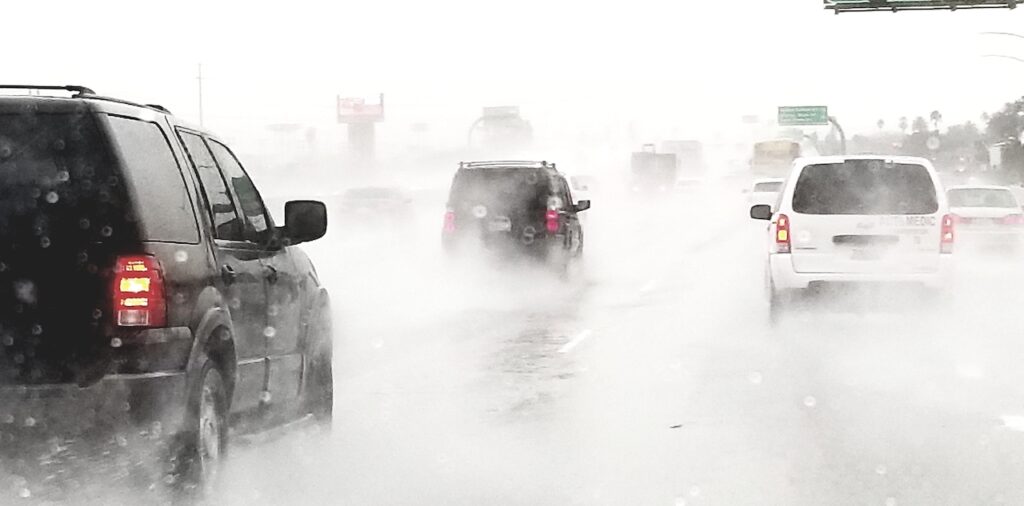Nothing’s worse than looking outside and realizing you’re going to have to drive through a heavy downpour. Even with your windshield wipers at high speed, it can still be intimidating to face water-filled roads and avoid any damage to your vehicle. That’s why we’ve gathered seven safe driving tips for stormy weather.
Why It’s Crucial to Be Prepared?
According to the U.S. Department of Transportation, approximately 21% of all car crashes in the U.S. are weather-related. Of those, 70% occur on wet pavement and 46% during rainfall. This statistic underscores the importance of taking extra precautions while driving during rain to ensure road safety.
The Biggest Factors Contributing to Accidents in Rainy Weather
Several factors contribute to accidents on wet roads. Some of the most common include:
- Reduced visibility due to heavy rain, fog, or mist.
- Slippery surfaces from water mixing with oil and dirt on the road.
- Hydroplaning, where tires lose contact with the road surface and cause a loss of control.
- Poorly maintained vehicles, such as worn tires or malfunctioning windshield wipers.
- Lack of driver experience in handling wet roads.
To avoid accidents caused by these factors, it’s important to take precautions and implement these safe driving tips when faced with wet road conditions.
7 Safe Driving Tips for Rainy Roads
Here are seven tips to help you drive safely on wet roads.
1. Prepare Your Vehicle
Before heading out on a rainy day, it’s important to make sure your car is prepared using these three steps:
- Check and maintain your tires for proper tread depth
- Ensure your windshield wipers are in good condition
- Test your vehicle’s headlights and brake lights
2. Adjust Your Driving Style
Consider how cautious you normally drive and triple that amount. Driving in wet weather calls for reduced speed and a much larger following distance. Make sure to avoid any sudden maneuvers like sharp turns or abrupt braking. Plus, don’t forget to use your headlights and turn signals so cars around you know where you’re going.
3. Safely Handle Hydroplaning
Hydroplaning is a dangerous condition where your vehicle’s tires lose contact with the road because of an overflow of water on the road’s surface, which leads to a loss of control. You can recognize hydroplaning if your steering suddenly becomes light, the engine noise changes, or you don’t feel the road while driving. If you think you’re hydroplaning:
- Avoid braking or accelerating quickly.
- Keep a firm grip on the steering wheel and steer straight.
- Slowly take your foot off the gas until you regain control of your vehicle.
Hydroplaning can be a scary experience, but with the right maneuvering, you can gain control of your vehicle quickly.
4. Be Mindful of Road Conditions
Rain can cause road surfaces to gain oil buildup, creating slick spots that are hard to see. Plus, some areas may be prone to flooding during a heavier downpour. It’s important to avoid these areas and use extra caution when driving on any road surfaces that appear wet.
5. Stay Informed and Plan Ahead
If you’re planning a big trip during the rainy season, it’s best to check weather forecasts before heading out. This way, you can avoid any dangerous weather conditions. You can also plan alternate routes ahead of time. Having these in advance of your trip can save significant time and avoid the stress of being stuck or rerouted in the middle of your journey.
6. Avoid Distractions
While driving in wet conditions, your only focus should be the road. You should not drive if you’re feeling drowsy. Instead, be sure you’re fully alert to your surroundings.
Distractions like texting, eating, or adjusting music can also divert your attention and increase your risk of getting into an accident. Make sure to stay focused on the task at hand—getting to your destination safely.
7. Know When to Stop
Sometimes the weather is just too severe for safe driving. Prioritize your safety over getting to your destination. If you’re feeling overwhelmed or unsafe while driving in heavy rain, it’s best to pull over and wait until conditions improve. Be sure to turn on your hazard lights and move away from the roadway as much as possible.
Remember, always prioritize safety over speed when driving on wet roads. With these safe driving tips, you can confidently navigate through any stormy weather and arrive at your destination safely.
Maintain Your Car’s Value During the Rainy Season with Valley Collision & Auto Repair
At Valley Collision, we understand that despite taking precautions, accidents can still happen. That’s why our team is here to provide expert collision repair services when you need them most. We’re committed to ensuring your vehicle is restored to its former glory, so you can get back on the road safely. Contact us to get a free quote!

